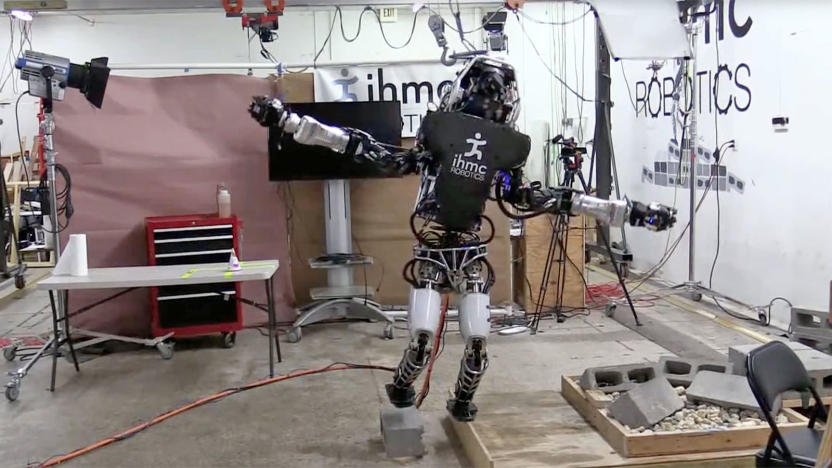IHMC
Latest

This ostrich robot doesn't need to think to run
This tiny ostrich bot, unlike rival robots, doesn't use computers and sensors to balance. It manages to keep running (at up to 10 mph) thanks to dynamic stability inherent in its design. Jerry Pratt, the senior research scientist at IHMC who leads the team developing the Planar Elliptical Runner (PER) told Technology Review that lessons learned from designing it could be applied to more practical running robots "to make them more efficient and natural looking. Running will be eventually useful for any application that you want to do quickly and where wheels can't work well."

Watch Boston Dynamics' humanoid robot balance on one foot
Humanoid robots still have problems staying upright, especially in tricky situations, but it's evident that they're making some progress. IHMC has posted a video showing Boston Dynamics' Atlas robot balancing on one foot on the edge of a plywood board about 0.8 inches thick. The feat is a "lucky run," IHMC admits (it's rare that the robot stays poised for so long), but it's relatively effortless. The worst you see before the fall is shaking as IHMC's algorithm sometimes makes poor estimates of the robot's state.

ICYMI: DARPA Bots doing chores, VR fight action and more
#fivemin-widget-blogsmith-image-293926{display:none;} .cke_show_borders #fivemin-widget-blogsmith-image-293926, #postcontentcontainer #fivemin-widget-blogsmith-image-293926{width:570px;display:block;} try{document.getElementById("fivemin-widget-blogsmith-image-293926").style.display="none";}catch(e){}Today on In Case You Missed It: A team that placed in the most recent DARPA challenge is still testing its robot, only now the tasks are more house-related. The IHMC has found that they can best tell whether their bot is responding well to new software by seeing how it handles common chores around the garage.

Google-powered machines lead DARPA's Robotics Challenge (video)
And you thought the Big Dog was scary? Okay, Boston Dynamics' quadrupedal, un-tip-overable 'bot still takes the cake, but SCHAFT (pictured above) deserves its own condo in the uncanny valley. And to think, they'll both be eating together at a cafeteria in Mountain View soon. That 'bot won DARPA's rescue-oriented competition this weekend by successfully navigating tricky terrain and clearing debris. Two other teams, IHMC Robotics and MIT, earned respective second and fourth places with variants on Boston Dynamics' Atlas machine. Other top-ranking entries included third-place Tartan Rescue as well as RoboSimian, Traclabs, WRECS and Trooper. The high scores are useful for more than just bragging rights. These top eight teams will receive DARPA funding as they move on to the Robotics Challenge finals in late 2014; they'll have a big (metal) leg up versus rivals that will have to pay to play. Congratulations to all, but if you don't mind, we'll be keeping our distance from Google headquarters until we know exactly what Andy Rubin plans to do with his new army of metal men and beasts.

NASA and IHMC building X1 exoskeleton to give us a lift, keep us fit in space and on Earth
It's hard to deny the appeal of a space-bound robot like NASA's Robonaut 2, fears of subversion notwithstanding. The space agency and Florida's Institute for Human and Machine Cognition know it, and they want to put that technology into an exoskeleton with a nobler purpose than performing chores on space stations. The in-development X1 (not yet pictured) adapts the Robonaut's skills to a body-hugging frame with 10 points of movement that might give humans an assist when they need it the most. In space, the X1 could automate and add challenge to exercise for astronauts in low gravity, or provide the extra muscle for that fabled day we return to manned surface exploration. NASA envisions its exoskeleton having more grounded uses as well, such as rehabilitation for leg injuries or walking for those who never had the chance. Although we're not expecting a rapid turnaround knowing NASA's lengthy schedules, we might see the X1 in use sooner than most such products in the wake of a purposefully quick development cycle -- and, no doubt, a few interested customers here on Earth.


